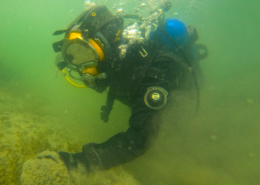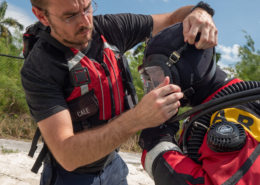What Does it Take to Become a PSD Instructor in the Modern World vs. the Old World?
Public safety diving is an offshoot to the sport of scuba diving that was born out of necessity. Just because lost items or individuals are submerged underwater does not mean that the responsibility of recovery is pushed aside. You must also remember that most scuba divers both now and in the past have chosen the sport in order to experience the underwater world and see things that you cannot see on dry land. In certain cases, this underwater world may extend into wrecks, caves, rivers, and other locations with the potential for bad visibility, but many divers seem to love good visibility, good conditions, and neat things to see. Conversely, bad guys rarely throw evidence or remains into the clear and calm local swimming hole. Instead, people with bad intentions often throw things they never wish to be found into the nastiest places they can find. From swamps to hog ponds, public safety divers often volunteer to venture into places where no person should ever go in order to help local communities.
Old school
In the early days of public safety diving, standardized education was not something the scuba training agencies had yet entertained. Instead, public safety departments often had a member who was a diver who performed tasks when needed underwater. As teams were developed, local or known dive instructors were brought in to teach public safety personnel how to dive as recreational divers. From that point, older divers and instructors were able to devise methods for accomplishing public safety objectives as needed. Essentially, the first dive teams were made up of recreational divers who used common sense to test operational methods underwater. When actions were successful, these methods were put into place as the standard for similar situations in the future. Many early public safety instructors were individuals who were members of, or in some way connected to, public safety departments. They were essentially subject matter experts who had the training and experience others felt was needed to come up with sensible practices for operational activities.
A secondary factor in early public safety diving was the presence of personal responsibility. Public safety personnel were focused on accomplishing objectives and knew that risks were going to be viewed as part of the job. If you recognize something foolish, you should be smart enough to stop. When departmental personnel got hurt, they fixed themselves and continued working. The public safety world of old was not one where departments were commonly sued by their own personnel.
New school
Over time, our society has become more and more litigious. With a larger microscope on how public safety departments operate, things began to change. Various public safety agencies started to develop basic public safety diver programs that could be implemented within departments or teams to begin the process of creating standardized training. Where there had once been no standard or regulation for training, the worry over what would be asked in the courtroom began to change training practices. Similarly, the concern over personnel injury was growing. The legal system was demanding workers compensation and the idea of getting a departmental individual hurt while performing potentially dangerous tasks was terrifying. Departments were often having to defend themselves from their own personnel. Liability was becoming a huge factor from which departments were seeking to protect themselves.
Emergency Response Diving International (ERDI) reviewed modern rules and regulations and used experienced professionals in the field to develop training programs that were compliant with the National Fire Protection Association (NFPA) and the Occupational Safety & Health Administration (OSHA). This ensured that training followed the basic safety regulations and structure that most public safety departments were working to follow. Similarly, the road to become a public safety dive instructor grew far more complicated than it once was, and for good reason. With the advent of paid public safety classes, many dive instructors were capitalizing on teaching scuba programs to dive teams all over the nation. The problem was that many of these individuals had no background in public safety diving. They were teaching recreational scuba courses to divers who would not be operating in a recreational environment.
Most of the agencies that developed true public safety diving programs created baseline requirements for public safety instructors. In most cases, these requirements included a history as a trained public safety diver and status as an active recreational scuba diver. Within a short period, agencies realized this was not enough to safely develop public safety dive instructors. New requirements were then put into place requiring training as a public safety diver instructor, beyond basic public safety diver education. These changes ensured that the instructors being created had a history in public safety diving, the ability to teach basic diving, and an educational background on how to teach public safety programs. Only recently have changes been established to allow an experienced public safety diver to become a public safety diver instructor without first becoming a recreational scuba instructor. The idea behind this most recent change is that dive team leaders may have vast experience in public safety but may have little value in training recreational divers. With the prerequisite training and experience, they can now move directly toward become educators strictly in the public safety diving realm.
In the old world of public safety diving, instructors were often experienced divers who used common sense to establish educational practices. These dive professionals often had years of experience and connections into public safety. The modern world allowed young and inexperienced instructors into the paid realm of public safety diver education. With worries over insurance coverage, the ability to justify actions in the courtroom, and worries over safety, new pathways were developed that require a public safety dive instructor to accomplish many tasks before he or she can ever teach a dive team alone. The positive aspect of this change is that modern instructors are force-fed safety protocols through their entire educational process and gain experience as they move forward. In many cases, modern instructors get to learn the common sense actions of old from the instructor trainers who work with them during this educational process.
If you are thinking of becoming a public safety instructor, make sure you understand that you are training divers to potentially dive in the worst conditions while using the support of a team to remain as safe as possible. To be able to accomplish this task, you must be a public safety diver first and understand what your students may experience in the real operational world. Then you must take the step to become an educator for your peers. This path is not easy but it very rewarding.
– Thomas Powell – Owner/Instructor Trainer – Air Hogs Scuba, Garner, NC




 Y. ZIN
Y. ZIN




Dejar un comentario
¿Quieres unirte a la conversación?Siéntete libre de contribuir!